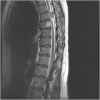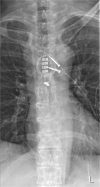Spinal cord stimulation in patients suffering from chronic pain after surgery for spinal intradural tumors: A case report and literature summary
- PMID: 36004480
- PMCID: PMC9804809
- DOI: 10.1111/papr.13156
Spinal cord stimulation in patients suffering from chronic pain after surgery for spinal intradural tumors: A case report and literature summary
Abstract
Background: The prevalence of pain after treatment of a spinal intradural tumor is remarkably high, approximately up to 40% of the patients suffer from central neuropathic pain. Publications on spinal cord stimulation (SCS) and its effect on pain caused by intradural spinal tumors are rare. We discuss the case of a patient suffering from chronic pain after removal of a Th7 level meningioma who was successfully treated with SCS and give an overview of the literature.
Methods: MEDLINE database was searched for neuropathic pain and intradural tumors.
Results: The initial search identified 35 articles, including hand-searched manuscripts. Six articles were included for analysis.
Case report: A 57-year-old female suffers from neuropathic pain in both legs after surgical removal of a Th7 level intradural meningioma. Postoperative magnetic resonance imaging shows no gross abnormalities, although she developed chronic pain in both legs. Pain in combination with side effects of analgesic intake are too disabling to have decent quality of life. A successful implantation of SCS is achieved at Th5 level as a treatment for the central neuropathic pain, and, at 36 months follow-up, there is significant pain relief and almost complete discontinuation of analgesics.
Discussion: Central pain from spinal intradural tumors may have a different mechanism of origin than pain seen after an acute spinal cord injury (SCI). However, the basic principles of neuromodulation are the same in both etiologies, as for successful stimulation intact pathways in the spinal cord are necessary. The efficacy of SCS as treatment in intradural spinal tumors is rarely described as only a handful of case reports are published. Interestingly, the case reports show that stimulation both above and below the lesion can be effective. In patients with incomplete SCI or intradural tumor resection stimulation below the lesion could be considered and tried in a trial setting before definitive implantation.
Keywords: chronic pain; spinal cord injury; spinal cord stimulation; spinal intradural tumor.
© 2022 The Authors. Pain Practice published by Wiley Periodicals LLC on behalf of World Institute of Pain.
Conflict of interest statement
The authors have nothing to disclose.
Figures
Similar articles
-
Current Evidence Lacking to Guide Clinical Practice for Spinal Cord Stimulation in the Treatment of Neuropathic Pain in Spinal Cord Injury: A Review of the Literature and a Proposal for Future Study.Pain Pract. 2020 Mar;20(3):325-335. doi: 10.1111/papr.12855. Epub 2020 Feb 10. Pain Pract. 2020. PMID: 31691496
-
Differential target multiplexed spinal cord stimulation using a paddle-type lead placed at the appropriate site for neuropathic pain after spinal cord injury in patients with past spinal surgical histories: study protocol for an exploratory clinical trial.Trials. 2023 Jun 13;24(1):395. doi: 10.1186/s13063-023-07433-7. Trials. 2023. PMID: 37308986 Free PMC article.
-
Does Fibromyalgia Affect the Outcomes of Spinal Cord Stimulation: An 11-Year, Multicenter, Retrospective Matched Cohort Study.Neuromodulation. 2023 Jan;26(1):206-214. doi: 10.1016/j.neurom.2022.05.004. Epub 2022 Jul 13. Neuromodulation. 2023. PMID: 35840522
-
The Effectiveness of Various Types of Electrical Stimulation of the Spinal Cord for Chronic Pain in Patients with Postherpetic Neuralgia: A Literature Review.Pain Res Manag. 2023 Mar 24;2023:6015680. doi: 10.1155/2023/6015680. eCollection 2023. Pain Res Manag. 2023. PMID: 37007861 Free PMC article. Review.
-
Cervical Spinal Cord Stimulation for Trigeminal Neuralgia: a Narrative Review.Curr Pain Headache Rep. 2022 Aug;26(8):639-645. doi: 10.1007/s11916-022-01066-2. Epub 2022 Jun 18. Curr Pain Headache Rep. 2022. PMID: 35716273 Review.
Cited by
-
Role of Posterior Longitudinal Ligament Complex in Spinal Deformity Secondary to Surgical Resection of the Intradural Tumor.Orthop Surg. 2023 Mar;15(3):819-828. doi: 10.1111/os.13636. Epub 2023 Jan 31. Orthop Surg. 2023. PMID: 36720712 Free PMC article.
References
-
- Kumar K, Hunter G, Demeria D. Spinal cord stimulation in treatment of chronic benign pain: challenges in treatment planning and present status, a 22‐year experience. Neurosurgery. 2006;58(3):481–96; discussion‐96. - PubMed
-
- Lee MG, Choi SS, Lee MK, Kong MH, Lee IO, Oh HR. Thoracic spinal cord stimulation for neuropathic pain after spinal meningioma removal: a case report. Clin J Pain. 2009;25(2):167–9. - PubMed
-
- Benedetti EM. Thoracic spinal cord stimulation is useful for pain treatment after incomplete cervical spinal cord injury. Colomb J Anesthesiol. 2013;41(2):146–9.
-
- Eisenberg E, Brecker C. Lumbar spinal cord stimulation for cervical‐originated central pain: a case report. Pain. 2002;100(3):299–301. - PubMed
Publication types
MeSH terms
LinkOut - more resources
Full Text Sources
Medical



